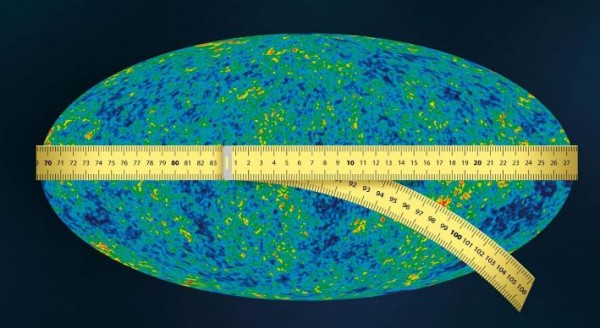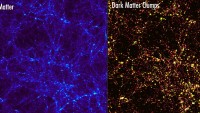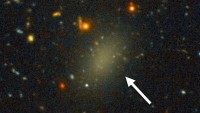Russians Measure Loss of Dark Matter since the Big Bang
| Arthur Dominic Villasanta | | Jan 03, 2017 09:01 AM EST |
(Photo : MIPT Press Office) The discrepancy between the cosmological parameters in the modern Universe and the Universe shortly after the Big Bang can be explained by the fact that the proportion of dark matter has decreased.
Russian physicists have calculated how much dark matter has been lost since the Big Bang, a discovery that explains the discrepancy between the cosmological parameters in the modern Universe and the Universe shortly after the Big Bang.
Using data from observations of various cosmological effects, the Russian researchers were able to give an estimate of the relative concentration of the decaying components of dark matter in the region of 2% to 5%.
Like Us on Facebook
"This means that in today's Universe there is 5% less dark matter than in the recombination era. We are not currently able to say how quickly this unstable part decayed," said Igor Tkachev, Head of the Department of Experimental Physics at INR and a lecturer at MIPT's Department of Fundamental Interactions and Cosmology.
"Dark matter may still be disintegrating even now, although that would be a different and considerably more complex model."
The recombination era took place some 300,000 years after the Big Bang. It describes the period of time in which the early Universe cooled enough for electrons and protons to form and bond together into hydrogen atoms.
Tkachev said scientists have, for the first time, been able to calculate how much dark matter could have been lost and what the corresponding size of the unstable component would be.
Astronomers first suspected there was a large proportion of "hidden mass" in the Universe back in the 1930s when Fritz Zwicky discovered "peculiarities" in a cluster of galaxies in the constellation Coma Berenices.
The galaxies moved as if they were under the effect of gravity from an unseen source. This hidden mass didn't manifest itself in any way except for a gravitational effect and was given the name dark matter.
Data from the Planck space telescope shows the proportion of dark matter in the Universe is 26.8%. The rest consists of "ordinary" or baryonic matter (4.9%) and dark energy (68.3%).
The nature of dark matter remains unknown up until today, however. Dark matter's properties might help scientists solve the problem that arose after studying observations from the Planck telescope.
The Planck space telescope accurately measured the fluctuations in the temperature of the cosmic microwave background radiation, or the "echo" of the Big Bang. By measuring these fluctuations, researchers were able to calculate key cosmological parameters using observations of the Universe in the recombination era.
"However, it turned out that some of these parameters, namely the Hubble parameter, which describes the rate of expansion of the Universe, and also the parameter associated with the number of galaxies in clusters vary significantly with data that we obtain from observations of the modern Universe, by directly measuring the speed of expansion of galaxies and studying clusters," said Tkachev.
"This variance was significantly more than margins of error and systematic errors known to us. Therefore we are either dealing with some kind of unknown error, or the composition of the ancient Universe is considerably different to the modern Universe."
The discrepancy can be explained by the decaying dark matter (DDM) hypothesis, which states that in the early Universe there was more dark matter, but then part of it decayed.
The authors of the study were Tkachev, Dmitry Gorbunov and Anton Chudaykin from IRN, MIPT and NSU.
Tagsdark matter, Big Bang, Russian physicists, Igor Tkachev, Universe, planck space telescope, Dmitry Gorbunov, Anton Chudaykin
©2015 Chinatopix All rights reserved. Do not reproduce without permission
EDITOR'S PICKS
-

Did the Trump administration just announce plans for a trade war with ‘hostile’ China and Russia?
-

US Senate passes Taiwan travel bill slammed by China
-

As Yan Sihong’s family grieves, here are other Chinese students who went missing abroad. Some have never been found
-

Beijing blasts Western critics who ‘smear China’ with the term sharp power
-

China Envoy Seeks to Defuse Tensions With U.S. as a Trade War Brews
-

Singapore's Deputy PM Provides Bitcoin Vote of Confidence Amid China's Blanket Bans
-

China warns investors over risks in overseas virtual currency trading
-

Chinese government most trustworthy: survey
-

Kashima Antlers On Course For Back-To-Back Titles
MOST POPULAR
LATEST NEWS
Zhou Yongkang: China's Former Security Chief Sentenced to Life in Prison

China's former Chief of the Ministry of Public Security, Zhou Yongkang, has been given a life sentence after he was found guilty of abusing his office, bribery and deliberately ... Full Article
TRENDING STORY

China Pork Prices Expected to Stabilize As The Supplies Recover

Elephone P9000 Smartphone is now on Sale on Amazon India

There's a Big Chance Cliffhangers Won't Still Be Resolved When Grey's Anatomy Season 13 Returns

Supreme Court Ruled on Samsung vs Apple Dispute for Patent Infringement

Microsoft Surface Pro 5 Rumors and Release Date: What is the Latest?













